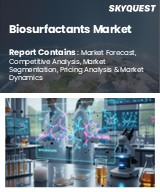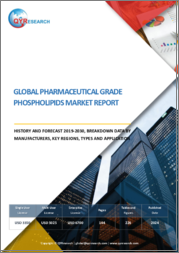
|
시장보고서
상품코드
1508694
인지질 시장 : 세계 산업 분석, 규모, 점유율, 성장, 동향 및 예측(2024-2033년)Phospholipids Market: Global Industry Analysis, Size, Share, Growth, Trends, and Forecast, 2024-2033 |
||||||
Persistence Market Research는 최근 세계 인지질 시장에 대한 종합적인 보고서를 발표했습니다. 이 보고서는 촉진요인, 동향, 기회 및 과제를 포함한 주요 시장 역학을 철저히 평가하고 시장 구조에 대한 심층적인 통찰력을 제공합니다.
주요 인사이트
- 인지지질 시장 규모(2024년) : 34억 달러
- 2033년 예상 시장 규모 : 66억 달러
- 세계 시장 성장률(2024-2033년 CAGR) : 7.50%
인지질 시장 - 보고서 범위
인지질은 의약품, 건강보조식품, 화장품, 식품가공 등 다양한 산업에서 중요한 역할을 하고 있습니다. 이들 분자는 세포막의 중요한 구조적 구성성분으로 작용하며, 약물 전달 시스템, 영양 보충제, 기능성 식품에 적용되고 있습니다. 인지질 시장은 다양한 분야에 대응하여 포스파티딜콜린, 포스파티딜세린, 포스파티딜에탄올아민 등의 제품을 제공합니다.
시장 성장의 촉진요인
세계 인지질 시장은 건강 효과로 인해 인지질 강화 기능성 식품 소재 및 건강 보조 식품에 대한 수요 증가와 같은 몇 가지 중요한 요인에 의해 주도되고 있습니다. 또한, 의약품의 생체 이용률과 효능을 높이기 위해 인지질 기반 약물 전달 시스템에 대한 제약 산업의 의존도가 높아지고 있는 것도 시장 확대의 원동력이 되고 있습니다. 또한, 추출 기술 및 지속 가능한 조달 방법의 발전은 비용 효율적인 생산과 환경적 지속가능성을 보장함으로써 시장 성장에 기여하고 있습니다.
시장 성장 억제요인
유망한 성장 전망에도 불구하고 인지질 시장은 복잡한 규제, 특히 건강 강조 표시 및 제품 라벨링에 대한 문제에 직면해 있습니다. 인지질 기반 제품의 안전성과 효능을 규정하는 엄격한 규제는 제조업체에 규정 준수에 대한 부담을 가중시키고 시장 진입 기회를 제한하고 있습니다. 또한, 변동하는 원자재 가격과 공급망 혼란은 시장 참여자들에게 생산 비용과 수익성에 영향을 미치는 도전과제를 야기합니다.
시장 기회
인지질 시장은 인지질 강화 제품의 건강 효과에 대한 소비자의 인식이 높아지고 새로운 치료 분야에서의 적용이 확대되면서 큰 성장 기회를 제공합니다. 인지질은 유화 및 보습 효과가 있어 스킨케어 제제 및 화장품에 배합되면 시장 확대의 새로운 길을 열어줄 수 있습니다. 새로운 인지질 제제 개발을 위한 전략적 제휴, 연구 투자, 제품 혁신을 통해 시장 경쟁력과 지속가능성을 더욱 강화할 수 있습니다.
본 보고서에서 다룬 주요 질문들
- 세계 인지질 시장의 성장을 가속하는 주요 요인은?
- 다양한 시장 부문에서 인지질 채택을 촉진하는 응용 분야와 산업은 무엇인가?
- 기술의 발전은 인지질 시장 경쟁 구도를 어떻게 변화시키고 있는가?
- 인지질 시장에 기여하는 주요 기업은 어디이며, 시장 관련성을 유지하기 위해 어떤 전략을 취하고 있는가?
- 세계 인지질 시장의 새로운 트렌드와 전망은?
목차
제1장 주요 요약
제2장 시장 개요
- 시장 범위/분류
- 시장의 정의/범위/제한
제3장 주요 시장 동향
- 시장에 영향을 미치는 주요 동향
- 제품 혁신/개발 동향
제4장 주요 성공 요인
- 제품 채택/사용 상황 분석
- 제품 USP/특징
- 전략적 프로모션 전략
제5장 세계 시장 수요 분석
- 과거 시장 규모(톤) 분석, 2019년-2023년
- 현재 및 향후 시장 수량(톤) 예측, 2024년-2033년
- 전년대비 성장 동향 분석
제6장 세계 시장 - 가격 분석
- 지역별 가격 분석
- 세계 평균 가격 분석 벤치마크
제7장 세계 시장 수요 분석
- 과거 시장 매출(백만 달러) 분석, 2019년-2023년
- 현재 및 향후 시장 매출(백만 달러) 예측, 2024년-2033년
- 전년대비 성장 동향 분석
- 절대액 기회 분석
제8장 시장 배경
- 거시경제 요인
- 예측 요인 - 관련성과 영향
- 밸류체인 분석
- COVID-19 위기 - 영향 평가
- 시장 역학
- 인 지질 제조 공정 개요
- 적용되는 주요 규제
- 주요 발전
- 세계공급과 수요 분석
제9장 세계 시장 분석 : 유형별
- 서론/주요 조사 결과
- 과거 시장 규모(백만 달러)와 수량 분석 : 유형별, 2019년-2023년
- 현재 및 향후 시장 규모(백만 달러)와 수량 분석과 예측 : 유형별, 2024년-2033년
- Phosphatidylserine
- Phosphatidylcholine
- 기타
- 시장의 매력 분석 : 유형별
제10장 세계 시장 분석 : 유래별
- 서론/주요 조사 결과
- 과거 시장 규모(백만 달러)와 수량 분석 : 유래별, 2019년-2023년
- 현재 및 향후 시장 규모(백만 달러)와 수량 분석과 예측 : 유래별, 2024년-2033년
- 대두
- 해바라기
- 계란
- 기타
- 시장의 매력 분석 : 유래별
제11장 세계 시장 분석 : 최종사용자별
- 서론/주요 조사 결과
- 과거 시장 규모(백만 달러)와 수량 분석 : 최종사용자별, 2019년-2023년
- 현재 및 향후 시장 규모(백만 달러)와 수량 분석과 예측 : 최종사용자별, 2024년-2033년
- 식품 및 음료
- 식이보충제
- 의약품
- 기타
- 시장의 매력 분석 : 최종사용자별
제12장 세계 시장 분석 : 지역별
- 서론
- 과거 시장 규모(백만 달러)와 수량 분석 : 지역별, 2019년-2023년
- 현재 시장 규모(백만 달러)와 수량 분석과 예측 : 지역별, 2024년-2033년
- 북미
- 라틴아메리카
- 유럽
- 남아시아 및 태평양
- 동아시아
- 중동 및 아프리카(MEA)
- 시장의 매력 분석 : 지역별
제13장 북미 시장 분석
제14장 라틴아메리카 시장 분석
제15장 유럽 시장 분석
제16장 남아시아·태평양 시장 분석
제17장 동아시아 시장 분석
제18장 중동 및 아프리카 시장 분석
제19장 국가별 분석, 2024년-2033년
- 미국 시장 분석
- 캐나다 분석
- 멕시코 분석
- 브라질 분석
- 독일 분석
- 이탈리아 분석
- 프랑스 분석
- 영국 분석
- 스페인 분석
- 러시아 분석
- 나카코쿠분석
- 일본 분석
- 한국 분석
- 인도 분석
- 동남아시아국가연합(ASEAN) 분석
- 호주 및 뉴질랜드 분석
- 튀르키예 분석
- 남아프리카공화국 분석
제20장 시장 구조 분석
- 시장 분석 : 기업 Tier별
- 시장 집중
- 주요 기업의 시장 점유율 분석
제21장 경쟁 분석
- 경쟁 대시보드
- 경쟁 벤치마킹
- 경쟁 상세 정보
- Cargill Incorporated
- Archer Daniels Midland Company
- Evonik Industries AG
- Croda International Plc
- Bunge Ltd.
- Kewpie Corporation
- Wilmar International Ltd.
- Lipoid GmbH
- Lecico GmbH
- Lasenor Emul SL
- VAV Life Sciences Pvt. Ltd
- American Lecithin Company
- Soja Protein ad
제22장 사용된 전제조건과 두자어
제23장 조사 방법
LSH 24.07.18Persistence Market Research has recently released a comprehensive report on the worldwide market for phospholipids. The report offers a thorough assessment of crucial market dynamics, including drivers, trends, opportunities, and challenges, providing detailed insights into the market structure.
Key Insights:
- Phospholipids Market Size (2024E): USD 3.4 Billion
- Projected Market Value (2033F): USD 6.6 Billion
- Global Market Growth Rate (CAGR 2024 to 2033): 7.50%
Phospholipids Market - Report Scope:
Phospholipids play a crucial role in various industries, including pharmaceuticals, nutraceuticals, cosmetics, and food processing. These molecules serve as essential structural components of cell membranes and find applications in drug delivery systems, dietary supplements, and functional foods. The phospholipids market caters to diverse sectors, offering products such as phosphatidylcholine, phosphatidylserine, and phosphatidylethanolamine.
Market Growth Drivers:
The global phospholipids market is propelled by several key factors, including increasing demand for functional food ingredients and dietary supplements enriched with phospholipids due to their health benefits. The pharmaceutical industry's growing reliance on phospholipid-based drug delivery systems to enhance bioavailability and efficacy of drugs also drives market expansion. Moreover, advancements in extraction technologies and sustainable sourcing practices contribute to market growth by ensuring cost-effective production and environmental sustainability.
Market Restraints:
Despite promising growth prospects, the phospholipids market faces challenges related to regulatory complexities, particularly concerning health claims and product labeling. Stringent regulations governing the safety and efficacy of phospholipid-based products impose compliance burdens on manufacturers and limit market entry opportunities. Furthermore, fluctuating raw material prices and supply chain disruptions pose challenges for market players, impacting production costs and profitability.
Market Opportunities:
The phospholipids market presents significant growth opportunities driven by increasing consumer awareness about the health benefits of phospholipid-enriched products and expanding applications in novel therapeutic areas. The integration of phospholipids in skincare formulations and cosmetic products due to their emulsifying and moisturizing properties opens new avenues for market expansion. Strategic collaborations, research investments, and product innovation aimed at developing novel phospholipid formulations further enhance market competitiveness and sustainability.
Key Questions Answered in the Report:
- What are the primary factors driving the growth of the global phospholipids market?
- Which applications and industries are driving phospholipid adoption across different market segments?
- How are technological advancements reshaping the competitive landscape of the phospholipids market?
- Who are the key players contributing to the phospholipids market, and what strategies are they employing to maintain market relevance?
- What are the emerging trends and future prospects in the global phospholipids market?
Competitive Intelligence and Business Strategy:
Leading players in the global phospholipids market, including Cargill Incorporated, Croda International Plc., and Bunge Ltd., focus on innovation, product diversification, and strategic partnerships to gain a competitive edge. These companies invest in research and development to introduce advanced phospholipid formulations tailored to specific market needs, such as pharmaceutical-grade phospholipids and liposomal delivery systems. Collaboration with regulatory authorities and industry stakeholders facilitates market access and compliance with evolving regulatory standards, ensuring product safety and efficacy.
Key Companies Profiled:
- Cargill Incorporated
- Archer Daniels Midland Company
- Evonik Industries AG
- Croda International Plc
- Bunge Ltd.
- Kewpie Corporation
- Wilmar International Ltd.
- Lipoid GmbH
- Lecico GmbH
- Lasenor Emul SL
- VAV Life Sciences Pvt. Ltd
- American Lecithin Company
- Soja Protein a.d
Phospholipids Market Segmentation
By Type:
- Phosphatidylserine
- Phosphatidylcholine
By Source:
- Soy
- Sunflowers
- Eggs
By End Use:
- Food and Beverages
- Nutraceutical Supplements
- Pharmaceuticals
By Region:
- North America
- Latin America
- Europe
- South Asia Pacific
- East Asia
- Middle East and Africa (MEA)
Table of Contents
1. Executive Summary
- 1.1. Global Market Outlook
- 1.2. Demand Side Trends
- 1.3. Supply Side Trends
- 1.4. Technology Roadmap
- 1.5. Analysis and Recommendations
2. Market Overview
- 2.1. Market Coverage / Taxonomy
- 2.2. Market Definition / Scope / Limitations
3. Key Market Trends
- 3.1. Key Trends Impacting the Market
- 3.2. Product Innovation / Development Trends
4. Key Success Factors
- 4.1. Product Adoption / Usage Analysis
- 4.2. Product USPs / Features
- 4.3. Strategic Promotional Strategies
5. Global Market Demand Analysis 2019-2023 and Forecast, 2024-2033
- 5.1. Historical Market Volume (Tons) Analysis, 2019-2023
- 5.2. Current and Future Market Volume (Tons) Projections, 2024-2033
- 5.3. Y-o-Y Growth Trend Analysis
6. Global Market - Pricing Analysis
- 6.1. Regional Pricing Analysis by Source
- 6.2. Global Average Pricing Analysis Benchmark
7. Global Market Demand (in Value or Size in US$ Million) Analysis 2019-2023 and Forecast, 2024-2033
- 7.1. Historical Market Value (US$ Million) Analysis, 2019-2023
- 7.2. Current and Future Market Value (US$ Million) Projections, 2024-2033
- 7.2.1. Y-o-Y Growth Trend Analysis
- 7.2.2. Absolute $ Opportunity Analysis
8. Market Background
- 8.1. Macro-Economic Factors
- 8.1.1. Global GDP Growth Outlook
- 8.1.2. Global Population Growth
- 8.1.3. Manufacturing Value Added by Key Countries
- 8.1.4. Global Food and Beverage
- 8.1.5. Global Cosmetic Industry Outlook
- 8.1.6. Global Pharmaceutical Industry Overview
- 8.2. Forecast Factors - Relevance and Impact
- 8.2.1. Top company's historical growth
- 8.2.2. Growth of End User Sectors
- 8.2.3. GDP Growth
- 8.2.4. Growth of the Functional Foods Industry
- 8.2.5. Research and Development Expenditure
- 8.2.6. Clean Label and Ingredient Transparency
- 8.2.7. Pricing Dynamics
- 8.2.8. Increasing Consumption of Infant Formula-
- 8.2.9. Increasing importance of certification
- 8.3. Value Chain Analysis
- 8.3.1. Product Manufacturers
- 8.3.2. List of Suppliers/ Distributors
- 8.3.3. List of Probable End-use Industries
- 8.4. COVID-19 Crisis - Impact Assessment
- 8.4.1. Current Statistics
- 8.4.2. Short-Mid-Long Term Outlook
- 8.4.3. Likely Rebound
- 8.5. Market Dynamics
- 8.5.1. Drivers
- 8.5.2. Restraints
- 8.5.3. Opportunity Analysis
- 8.6. Phospholipid Production Process Overview
- 8.7. Key Applicable Regulations
- 8.8. Key Developments
- 8.9. Global Supply Vs. Demand Analysis
9. Global Market Analysis 2019-2023 and Forecast 2024-2033, by Type
- 9.1. Introduction / Key Findings
- 9.2. Historical Market Size (US$ Million) and Volume Analysis by Type, 2019-2023
- 9.3. Current and Future Market Size (US$ Million) and Volume Analysis and Forecast by Type, 2024-2033
- 9.3.1. Phosphatidylserine
- 9.3.2. Phosphatidylcholine
- 9.3.3. Others
- 9.4. Market Attractiveness Analysis by Type
10. Global Market Analysis 2019-2023 and Forecast 2024-2033, by Source
- 10.1. Introduction / Key Findings
- 10.2. Historical Market Size (US$ Million) and Volume Analysis by Source, 2019-2023
- 10.3. Current and Future Market Size (US$ Million) and Volume Analysis and Forecast by Source, 2024-2033
- 10.3.1. Soy
- 10.3.2. Sunflower
- 10.3.3. Egg
- 10.3.4. Others
- 10.4. Market Attractiveness Analysis by Source
11. Global Market Analysis 2019-2023 and Forecast 2024-2033, by End User
- 11.1. Introduction / Key Findings
- 11.2. Historical Market Size (US$ Million) and Volume Analysis by End User, 2019-2023
- 11.3. Current and Future Market Size (US$ Million) and Volume Analysis and Forecast by End User, 2024-2033
- 11.3.1. Food and beverage
- 11.3.2. Nutraceutical Supplements
- 11.3.3. Pharmaceuticals
- 11.3.4. Others
- 11.4. Market Attractiveness Analysis by End User
12. Global Market Analysis 2019-2023 and Forecast 2024-2033, by Region
- 12.1. Introduction
- 12.2. Historical Market Size (US$ Million) and Volume Analysis by Region, 2019-2023
- 12.3. Current Market Size (US$ Million) and Volume Analysis and Forecast by Region, 2024-2033
- 12.3.1. North America
- 12.3.2. Latin America
- 12.3.3. Europe
- 12.3.4. South Asia and Pacific
- 12.3.5. East Asia
- 12.3.6. Middle East and Africa (Middle East and Africa)
- 12.4. Market Attractiveness Analysis by Region
13. North America Market Analysis 2019-2023 and Forecast 2024-2033
- 13.1. Introduction
- 13.2. Pricing Analysis
- 13.3. Historical Market Size (US$ Million) and Volume Trend Analysis by Market Taxonomy, 2019-2023
- 13.4. Market Size (US$ Million) and Volume Forecast by Market Taxonomy, 2024-2033
- 13.4.1. by Country
- 13.4.1.1. U.S.
- 13.4.1.2. Canada
- 13.4.2. by Type
- 13.4.3. by Source
- 13.4.4. by End User
- 13.4.1. by Country
- 13.5. Market Attractiveness Analysis
- 13.5.1. by Country
- 13.5.2. by Type
- 13.5.3. by Source
- 13.5.4. by End User
14. Latin America Market Analysis 2019-2023 and Forecast 2024-2033
- 14.1. Introduction
- 14.2. Pricing Analysis
- 14.3. Historical Market Size (US$ Million) and Volume Trend Analysis by Market Taxonomy, 2019-2023
- 14.4. Market Size (US$ Million) and Volume Forecast by Market Taxonomy, 2024-2033
- 14.4.1. by Country
- 14.4.1.1. Brazil
- 14.4.1.2. Mexico
- 14.4.1.3. Rest of Latin America
- 14.4.2. by Type
- 14.4.3. by Source
- 14.4.4. by End User
- 14.4.1. by Country
- 14.5. Market Attractiveness Analysis
- 14.5.1. by Country
- 14.5.2. by Type
- 14.5.3. by Source
- 14.5.4. by End User
15. Europe Market Analysis 2019-2023 and Forecast 2024-2033
- 15.1. Introduction
- 15.2. Pricing Analysis
- 15.3. Historical Market Size (US$ Million) and Volume Trend Analysis by Market Taxonomy, 2019-2023
- 15.4. Market Size (US$ Million) and Volume Forecast by Market Taxonomy, 2024-2033
- 15.4.1. by Country
- 15.4.1.1. Germany
- 15.4.1.2. Italy
- 15.4.1.3. France
- 15.4.1.4. U.K.
- 15.4.1.5. Spain
- 15.4.1.6. BENELUX
- 15.4.1.7. Russia
- 15.4.1.8. Rest of Europe
- 15.4.2. by Type
- 15.4.3. by Source
- 15.4.4. by End User
- 15.4.1. by Country
- 15.5. Market Attractiveness Analysis
- 15.5.1. by Country
- 15.5.2. by Type
- 15.5.3. by Source
- 15.5.4. by End User
16. South Asia and Pacific Market Analysis 2019-2023 and Forecast 2024-2033
- 16.1. Introduction
- 16.2. Pricing Analysis
- 16.3. Historical Market Size (US$ Million) and Volume Trend Analysis by Market Taxonomy, 2019-2023
- 16.4. Market Size (US$ Million) and Volume Forecast by Market Taxonomy, 2024-2033
- 16.4.1. by Country
- 16.4.1.1. India
- 16.4.1.2. ASEAN
- 16.4.1.3. Oceania
- 16.4.1.4. Rest of South Asia and Pacific
- 16.4.2. by Type
- 16.4.3. by Source
- 16.4.4. by End User
- 16.4.1. by Country
- 16.5. Market Attractiveness Analysis
- 16.5.1. by Country
- 16.5.2. by Type
- 16.5.3. by Source
- 16.5.4. by End User
17. East Asia Market Analysis 2019-2023 and Forecast 2024-2033
- 17.1. Introduction
- 17.2. Pricing Analysis
- 17.3. Historical Market Size (US$ Million) and Volume Trend Analysis by Market Taxonomy, 2019-2023
- 17.4. Market Size (US$ Million) and Volume Forecast by Market Taxonomy, 2024-2033
- 17.4.1. by Country
- 17.4.1.1. China
- 17.4.1.2. Japan
- 17.4.1.3. South Korea
- 17.4.2. by Type
- 17.4.3. by Source
- 17.4.4. by End User
- 17.4.1. by Country
- 17.5. Market Attractiveness Analysis
- 17.5.1. by Country
- 17.5.2. by Type
- 17.5.3. by Source
- 17.5.4. by End User
18. Middle East and Africa Analysis 2019-2023 and Forecast 2024-2033
- 18.1. Introduction
- 18.2. Pricing Analysis
- 18.3. Historical Market Size (US$ Million) and Volume Trend Analysis by Market Taxonomy, 2019-2023
- 18.4. Market Size (US$ Million) and Volume Forecast by Market Taxonomy, 2024-2033
- 18.4.1. by Country
- 18.4.1.1. Gulf co-operation council countries
- 18.4.1.2. Turkey
- 18.4.1.3. Northern Africa
- 18.4.1.4. South Africa
- 18.4.1.5. Rest of Middle East and Africa
- 18.4.2. by Type
- 18.4.3. by Source
- 18.4.4. by End User
- 18.4.1. by Country
- 18.5. Market Attractiveness Analysis
- 18.5.1. by Country
- 18.5.2. by Type
- 18.5.3. by Source
- 18.5.4. by End User
19. Country Wise Analysis 2024-2033
- 19.1. U.S. Market Analysis
- 19.1.1. by Type
- 19.1.2. by Source
- 19.1.3. by End User
- 19.2. Canada Analysis
- 19.2.1. by Type
- 19.2.2. by Source
- 19.2.3. by End User
- 19.3. Mexico Analysis
- 19.3.1. by Type
- 19.3.2. by Source
- 19.3.3. by End User
- 19.4. Brazil Analysis
- 19.4.1. by Type
- 19.4.2. by Source
- 19.4.3. by End User
- 19.5. Germany Analysis
- 19.5.1. by Type
- 19.5.2. by Source
- 19.5.3. by End User
- 19.6. Italy Analysis
- 19.6.1. by Type
- 19.6.2. by Source
- 19.6.3. by End User
- 19.7. France Analysis
- 19.7.1. by Type
- 19.7.2. by Source
- 19.7.3. by End User
- 19.8. U.K. Analysis
- 19.8.1. by Type
- 19.8.2. by Source
- 19.8.3. by End User
- 19.9. Spain Analysis
- 19.9.1. by Type
- 19.9.2. by Source
- 19.9.3. by End User
- 19.10. Russia Analysis
- 19.10.1. by Type
- 19.10.2. by Source
- 19.10.3. by End User
- 19.11. China Analysis
- 19.11.1. by Type
- 19.11.2. by Source
- 19.11.3. by End User
- 19.12. Japan Analysis
- 19.12.1. by Type
- 19.12.2. by Source
- 19.12.3. by End User
- 19.13. South Korea Analysis
- 19.13.1. by Type
- 19.13.2. by Source
- 19.13.3. by End User
- 19.14. India Analysis
- 19.14.1. by Type
- 19.14.2. by Source
- 19.14.3. by End User
- 19.15. Association of Southeast Asian Nations (ASEAN) Analysis
- 19.15.1. by Type
- 19.15.2. by Source
- 19.15.3. by End User
- 19.16. Australia and New Zealand Analysis
- 19.16.1. by Type
- 19.16.2. by Source
- 19.16.3. by End User
- 19.17. Turkiye Analysis
- 19.17.1. by Type
- 19.17.2. by Source
- 19.17.3. by End User
- 19.18. South Africa Analysis
- 19.18.1. by Type
- 19.18.2. by Source
- 19.18.3. by End User
20. Market Structure Analysis
- 20.1. Market Analysis by Tier of Companies (De-Aromatic Solvents)
- 20.2. Market Concentration
- 20.3. Market Share Analysis of Top Players
21. Competition Analysis
- 21.1. Competition Dashboard
- 21.2. Competition Benchmarking
- 21.3. Competition Deep Dive
- 21.3.1. Cargill Incorporated
- 21.3.1.1. Overview
- 21.3.1.2. Product Portfolio
- 21.3.1.3. Profitability by Market Segments (Product/Channel/Region)
- 21.3.1.4. Sales Footprint
- 21.3.1.5. Strategy Overview
- 21.3.2. Archer Daniels Midland Company
- 21.3.2.1. Overview
- 21.3.2.2. Product Portfolio
- 21.3.2.3. Profitability by Market Segments (Product/Channel/Region)
- 21.3.2.4. Sales Footprint
- 21.3.2.5. Strategy Overview
- 21.3.3. Evonik Industries AG
- 21.3.3.1. Overview
- 21.3.3.2. Product Portfolio
- 21.3.3.3. Profitability by Market Segments (Product/Channel/Region)
- 21.3.3.4. Sales Footprint
- 21.3.3.5. Strategy Overview
- 21.3.4. Croda International Plc
- 21.3.4.1. Overview
- 21.3.4.2. Product Portfolio
- 21.3.4.3. Profitability by Market Segments (Product/Channel/Region)
- 21.3.4.4. Sales Footprint
- 21.3.4.5. Strategy Overview
- 21.3.5. Bunge Ltd.
- 21.3.5.1. Overview
- 21.3.5.2. Product Portfolio
- 21.3.5.3. Profitability by Market Segments (Product/Channel/Region)
- 21.3.5.4. Sales Footprint
- 21.3.5.5. Strategy Overview
- 21.3.6. Kewpie Corporation
- 21.3.6.1. Overview
- 21.3.6.2. Product Portfolio
- 21.3.6.3. Profitability by Market Segments (Product/Channel/Region)
- 21.3.6.4. Sales Footprint
- 21.3.6.5. Strategy Overview
- 21.3.7. Wilmar International Ltd.
- 21.3.7.1. Overview
- 21.3.7.2. Product Portfolio
- 21.3.7.3. Profitability by Market Segments (Product/Channel/Region)
- 21.3.7.4. Sales Footprint
- 21.3.7.5. Strategy Overview
- 21.3.8. Lipoid GmbH
- 21.3.8.1. Overview
- 21.3.8.2. Product Portfolio
- 21.3.8.3. Profitability by Market Segments (Product/Channel/Region)
- 21.3.8.4. Sales Footprint
- 21.3.8.5. Strategy Overview
- 21.3.9. Lecico GmbH
- 21.3.9.1. Overview
- 21.3.9.2. Product Portfolio
- 21.3.9.3. Profitability by Market Segments (Product/Channel/Region)
- 21.3.9.4. Sales Footprint
- 21.3.9.5. Strategy Overview
- 21.3.10. Lasenor Emul SL
- 21.3.10.1. Overview
- 21.3.10.2. Product Portfolio
- 21.3.10.3. Profitability by Market Segments (Product/Channel/Region)
- 21.3.10.4. Sales Footprint
- 21.3.10.5. Strategy Overview
- 21.3.11. VAV Life Sciences Pvt. Ltd
- 21.3.11.1. Overview
- 21.3.11.2. Product Portfolio
- 21.3.11.3. Profitability by Market Segments (Product/Channel/Region)
- 21.3.11.4. Sales Footprint
- 21.3.11.5. Strategy Overview
- 21.3.12. American Lecithin Company
- 21.3.12.1. Overview
- 21.3.12.2. Product Portfolio
- 21.3.12.3. Profitability by Market Segments (Product/Channel/Region)
- 21.3.12.4. Sales Footprint
- 21.3.12.5. Strategy Overview
- 21.3.13. Soja Protein a.d
- 21.3.13.1. Overview
- 21.3.13.2. Product Portfolio
- 21.3.13.3. Profitability by Market Segments (Product/Channel/Region)
- 21.3.13.4. Sales Footprint
- 21.3.13.5. Strategy Overview
- 21.3.1. Cargill Incorporated



















